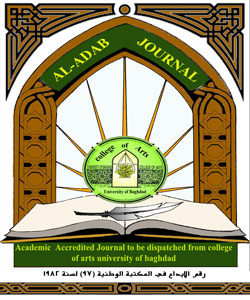Rooting the concept of integrity in university education, an academic map to enhance integrity with public relations concepts
DOI:
https://doi.org/10.31973/aj.v0i113.1424Keywords:
/Abstract
Within the rapid communication and technological developments in the world today become for public relations specialists, researchers and international centers for studies and development in various fields and disciplines, is no longer confined to its job on the etiquette and protocol, organizing concerts and events, but beyond that to being a function contribute to the support and development of production and service institutions and even oversight institutions, need oversight institutions, in particular, has become a specialized and effective device that enable that institutions to inform what is going on around them of the developments and interactions between them and the political and social surroundings. Integrity is a human phenomenon governed by human laws and values of individuals and society, and that corresponds to this phenomenon is the goodness and the reform movement and in the contrast between these two phenomena is one of the factors which control Countries march on the ground and then control the march of human
Downloads
References
• فردوس عبدالحميد البهنساوي- منظومة التعليم العالي بالولايات المتحدة الأمريكية ، عالم الكتب، القاهرة 2006 ص 242.
• د. كامل حسون القيم، مناهج وأساليب كتابة البحث العلمي في الدراسات الإنسانية ، ط 1 ، بغداد، " مركز حمورابي للبحوث والدراسات الإستراتيجية 1212 " ص112.
• علاء صالح فياض العبودي- توظيف الوسائط المتعددة في المواقع الالكترونية الصحفية العراقية رسالة غير منشورة، كلية الإعلام– جامعة بغداد،2011 ص1.
• عبد الحافظ سلامة ، الاتصال وتكنولوجيا التعليم، ( عمان : دار اليازوردي العلمية للنشر والتوزيع ، 2001 )، ص108.
• د. عبد المجيد عثمان، التعلم الالكتروني، الوضع الراهن وآفاق المستقبَل، www.abegs.org.
• بشير، سعد زغلول، دليلك إلى البرنامج الإحصائي SPSS، جمهورية العراق، المعهد العربي للتدريب والبحوث الإحصائية، 2002.
• تقرير هيأة تعليم العلاقات العامة الأمريكية ، الملخص التنفيذي ( الصلة المهنية: تعليم العلاقات العامة للقرن الحادي والعشرين) نوفمبر 2006 م،على الموقع www.commpred.org.
• Kempthorne,O&Hinkelmann,K,(1994),”Designs And Aalysis of Experiments”, John Wiley&Sons,Inc, USA.
• Scheffe,H.(1959).”The Analysis of Variance”, John Wiley&Sons,Inc, USA.
• Frigon,N.L,&Mathews,O(2002),”Parctical Guide to Experimental Designs ”, John Wiley&Sons,Inc, USA..
• أ.د عبد الرزاق محمد الدليمي، العلاقات العامة، رؤية معاصرة، ط1 دار وائل للنشر ، الاردن – عمان 2010.
• أ.د محمد منير حجاب ، العلاقات العامة في المؤسسات الحديثة، دار الفجر للنشر والتوزيع 2007، القاهرة.
• أ.د وليد حسن الحديثي ، فن الاقناع – اللغة والحوار-ط1 2013، دار ضفاف للطباعة والنشر والتوزيع ، العراق –بغداد.
• حسين ميران عجيل ، فاعلية التعليم الحديث لترسيخ ثقافة النزاهة في المؤسسات التربوية ، مجلة النزاهة والشفافية للبحوث والدراسات العدد (6).
• د. صباح حسن عبد الزبيدي ، مقترح تصميم مساق تعليمي في مضمون النزاهة ودليل تدريسه لطلاب المرحلة الابتدائية في العراق ، بحث مقدم لمؤتمر النزاهة العامة – بغداد 2008.
• م. رعد كاظم غيدان ، الاستراتيجية الوطنية لحماية النزاهة ومكافحة الفساد في العراق (2010-2014) ، نشر في 2009.
• د. سفيان صائب المعاضيدي ، بناء مفهوم النزاهة في المناهج التربوية العراقية 2008
Downloads
Published
Issue
Section
License
Copyright and Licensing:
For all articles published in Al-Adab journal, copyright is retained by the authors. Articles are licensed under an open access Creative Commons CC BY 4.0 license, meaning that anyone may download and read the paper for free. In addition, the article may be reused and quoted provided that the original published version is cited. These conditions allow for maximum use and exposure of the work.
Reproducing Published Material from other Publishers: It is absolutely essential that authors obtain permission to reproduce any published material (figures, schemes, tables or any extract of a text) which does not fall into the public domain, or for which they do not hold the copyright. Permission should be requested by the authors from the copyrightholder (usually the Publisher, please refer to the imprint of the individual publications to identify the copyrightholder).
Permission is required for: Your own works published by other Publishers and for which you did not retain copyright.
Substantial extracts from anyones' works or a series of works.
Use of Tables, Graphs, Charts, Schemes and Artworks if they are unaltered or slightly modified.
Photographs for which you do not hold copyright.
Permission is not required for: Reconstruction of your own table with data already published elsewhere. Please notice that in this case you must cite the source of the data in the form of either "Data from..." or "Adapted from...".
Reasonably short quotes are considered fair use and therefore do not require permission.
Graphs, Charts, Schemes and Artworks that are completely redrawn by the authors and significantly changed beyond recognition do not require permission.
Obtaining Permission
In order to avoid unnecessary delays in the publication process, you should start obtaining permissions as early as possible. If in any doubt about the copyright, apply for permission. Al-Adab Journal cannot publish material from other publications without permission.
The copyright holder may give you instructions on the form of acknowledgement to be followed; otherwise follow the style: "Reproduced with permission from [author], [book/journal title]; published by [publisher], [year].' at the end of the caption of the Table, Figure or Scheme.












